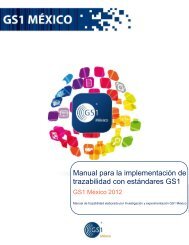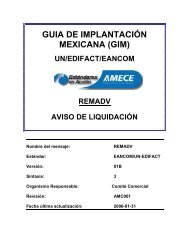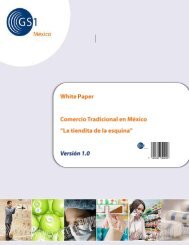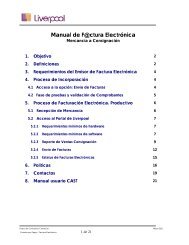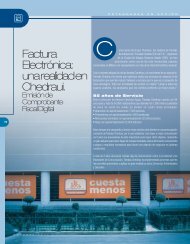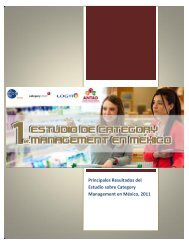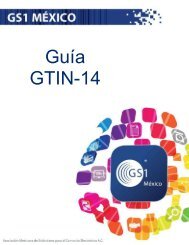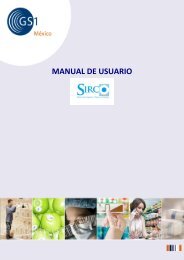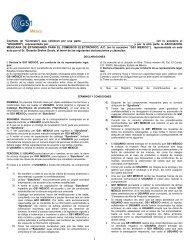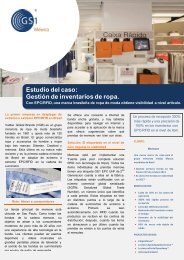Fuente Confiable de Datos GS1 - GS1 México
Fuente Confiable de Datos GS1 - GS1 México
Fuente Confiable de Datos GS1 - GS1 México
You also want an ePaper? Increase the reach of your titles
YUMPU automatically turns print PDFs into web optimized ePapers that Google loves.
FUENTE CONFIABLE DE<br />
DATOS <strong>GS1</strong><br />
ESTÁNDAR RATIFICADO<br />
Rev. No. 1<br />
Fecha <strong>de</strong><br />
Emisión<br />
20/06/2013<br />
Página 58 <strong>de</strong> 66<br />
el caracter diagonal inicial e incluyendo todos los parámetros <strong>de</strong> consulta en el or<strong>de</strong>n<br />
elegidos por el Agregador <strong>de</strong> <strong>Datos</strong> “A”. Estos caracteres URL <strong>de</strong>berán ser tratados como<br />
octetos en la codificación US-ASCII para fines <strong>de</strong> cálculo. La clave inicial para el algoritmo<br />
HMAC es K A B como se dijo previamente durante el acuerdo <strong>de</strong> confianza, que el<br />
Agregador <strong>de</strong> <strong>Datos</strong> “A” toma como una función <strong>de</strong> la URL <strong>de</strong> servicio <strong>de</strong> “B”.<br />
Por ejemplo, si el URL solicitado (antes <strong>de</strong> añadirle el parámetro MAC) es el siguiente:<br />
http://tsd.example.com/service/v1/productData/gtin/00614141123452target<br />
Market=840&dataVersion=1.0&clientGln=0614141000005<br />
Entonces la entrada <strong>de</strong>l algoritmo HMAC son los siguientes caracteres, codificados como<br />
octetos <strong>de</strong> US-ASCII:<br />
/service/v1/productData/gtin/00614141123452targetMrket=840&dateVersion=1.0&clientGl<br />
n=0614141000005<br />
3. El mensaje <strong>de</strong>l código <strong>de</strong> autentificación resultante se convierte en una ca<strong>de</strong>na<br />
hexa<strong>de</strong>cimal <strong>de</strong> 64 caracteres (utilizando letras en mayúscula) y adjunto a la solicitud URL<br />
como el valor <strong>de</strong>l parámetro MAC.<br />
4. El URL final es usado para hacer la solicitud HTTP.<br />
El Agregador <strong>de</strong> <strong>Datos</strong> “B” <strong>de</strong>l servidor DEBERÁ autentificar la i<strong>de</strong>ntidad <strong>de</strong>l Agregador <strong>de</strong> <strong>Datos</strong><br />
“A” <strong>de</strong>l cliente <strong>de</strong> la siguiente manera:<br />
1. El Agregador <strong>de</strong> <strong>Datos</strong> “B” recibe la solicitud HTTP.<br />
2. Utilizando el valor <strong>de</strong>l parámetro ClientGln, el Agregador <strong>de</strong> <strong>Datos</strong> “B” busca la clave K A B<br />
correspondiente. Si no existe esta clave, se <strong>de</strong>tiene: el cliente es <strong>de</strong>sconocido y aparece la<br />
Excepción <strong>de</strong> Seguridad (SecurityException).<br />
3. El Agregador <strong>de</strong> <strong>Datos</strong> “B” calcula un código <strong>de</strong> mensaje <strong>de</strong> autentificación utilizando<br />
HMAC-SHA256, don<strong>de</strong> la entrada <strong>de</strong> información al algoritmo HMAC es el camino y la<br />
consulta <strong>de</strong> porciones <strong>de</strong>l URL solicitado incluyendo el carácter <strong>de</strong> diagonal inicial, e<br />
incluyendo todos los parámetros <strong>de</strong> búsqueda excepto el parámetro MAC y don<strong>de</strong> la clave<br />
es K A B.<br />
4. El Agregador <strong>de</strong> <strong>Datos</strong> “B” compara al MAC calculado en la etapa anterior con el MAC<br />
incluido en la solicitud URL <strong>de</strong> parámetro <strong>de</strong> MAC. Si los MACs son idénticos, entonces la<br />
i<strong>de</strong>ntidad <strong>de</strong>l Agregador <strong>de</strong> <strong>Datos</strong> “A” es autentificada. De otra forma, se <strong>de</strong>tiene: el cliente<br />
no está autentificado y aparece la Excepción <strong>de</strong> Seguridad (SecurityException).<br />
El Agregador <strong>de</strong> <strong>Datos</strong> <strong>de</strong> servicio no autentifica al Agregador <strong>de</strong> <strong>Datos</strong> <strong>de</strong>l cliente antes <strong>de</strong> que la<br />
solicitud sea entregada <strong>de</strong>l cliente al servidor. En cambio, el Agregador <strong>de</strong> <strong>Datos</strong> <strong>de</strong> servicio<br />
proporciona un MAC en respuesta, para que así el cliente pueda autentificar al servidor cuando<br />
reciba la respuesta.<br />
Cuando el servicio <strong>de</strong> Agregador <strong>de</strong> <strong>Datos</strong> “B” respon<strong>de</strong> a una solicitud <strong>de</strong> AAQI hecha por el<br />
cliente Agregador <strong>de</strong> <strong>Datos</strong> “A”, ésta DEBERÁ incluir un Código <strong>de</strong> Autentificación <strong>de</strong> Mensaje<br />
(MAC) <strong>de</strong> la siguiente manera:<br />
1. El Agregador <strong>de</strong> <strong>Datos</strong> “B” calcula un mensaje <strong>de</strong> código <strong>de</strong> autentificación utilizando el<br />
HMAC-SHA256 don<strong>de</strong> la entrada <strong>de</strong> información al algoritmo HMAC es la totalidad <strong>de</strong> la<br />
Este documento es propiedad <strong>de</strong> <strong>GS1</strong> MEXICO. Se prohíbe la copia parcial o total <strong>de</strong>l documento sin el consentimiento <strong>de</strong>l titular.



